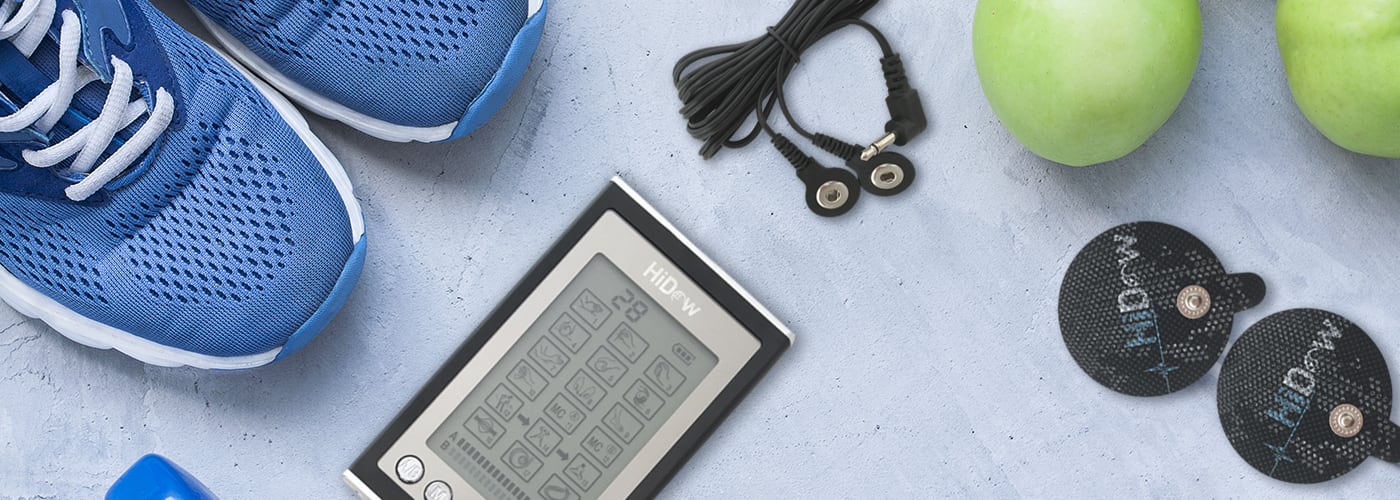Have you been experiencing chronic hip pain from a previous injury, whether sports-related or general wear and tear? You’re not alone. Chronic hip pain is a common occurrence in many adults that are treated by transcutaneous electrical nerve stimulation (TENS) therapy. At HiDow International, we specialize in delivering the best TENS/EMS devices available to those who suffer from chronic hip pain. TENS, commonly called e-stim, is a great way to alleviate nerve pain by disrupting the pain signals on the top nerves. Here’s how to use a TENS unit for hip pain relief.
About Hip Pain
Hip pain is a common condition caused by injuries, inflamed tendons, and arthritis. When a person experiences hip pain, it can be an uncomfortable feeling that limits their range of motion and can leave many people feeling stuck. Luckily, there are a lot of ways that you can treat hip pain through physical therapy, stretching, and e-stim. Note that because there are many causes for hip pain, it’s best to consult with your healthcare provider to see which pain treatment is appropriate for you.
Many times, healthcare providers and physical therapists will turn to transcutaneous electrical nerve stimulation (TENS) devices. This device disrupts pain signals before they reach pain receptors, which can be done at home with a personal TENS device from HiDow.
Is a TENS Machine Good for Hip Pain?
If you are new to using a TENS device, they send an electrical signal to the top nerves in your body to disrupt pain signals. That being said, YES, TENS devices are perfect for helping you relieve any pain related to muscles, ligaments, and tendons. Though, you want to be sure that you do not use an e-stim device on the part of your body that doesn’t have enough muscle or fat.
Using a TENS device for Hip Pain
When it comes to treating hip pain with a TENS device, you want to make sure that you are sitting down in a comfortable chair. This will allow you to comfortably relax your hip and leg while you connect the electrodes.
1. The Best TENS Device to Use for Hip Pain
When treating your hip pain with an e-stim device, we recommend using a wireless unit. While you could use any TENS/EMS unit for hip pain, a wireless one will allow you to place the electrodes on your hip and set the actual device somewhere close by or even in your pocket without having to worry about getting tangled in the wires. A Popular model is the Pro Touch 6 – 12 which has up to 6 output channels and 12 settings.
2. TENS Electrode Placement for Hip Pain
We recommend using 2 output channels and 4 electrode pads for the best results.
While sitting, place 2 electrode pads diagonally across from each other. Place another 2 electrodes diagonally across each other, making an ‘X’ on your leg.
The affected pain area should be in the middle of this ‘X.’
For more electrode placement tips, here are 3 ways to place electrodes on your body while working out.
3. Find a Comfortable Setting and Relax
When using a TENS/EMS unit for any kind of pain relief. It’s important to find the setting that is most comfortable for you. The Pro Touch 6 – 12 has 12 different settings, so it can be difficult to choose the right one for you. We recommend starting with the lowest setting and working your way up until you find the one most comfortable.

Related Stories
Red, White, and Soothe: How HiDow Helps You Recover in the Heat
Recovery that works in winter doesn’t always hold up in the heat. The body reacts...
Jul
Massage Gun Showdown: How the Power Duo Compares to Traditional Methods
Have you ever considered that a handheld device could revolutionize your muscle recovery? With the...
Jun
Fatherly Fitness Tips For Men’s Health Month
Men’s Health Month is more than a date on the calendar—it’s a call to action....
Jun
Built to Move: The Everyday Recovery Edit
Movement is what keeps us going—literally. Whether it’s recovering after a run, loosening up after...
Jun
Unlocking The Secret To Tissue Injury Recovery With TENS/EMS Devices
Have you ever wondered why some injuries take longer to heal than others? Tissue injuries...
May
Get Mobile With HiDow TriggerFlex Tools & TriggerFlex 2.0
Tight muscles holding you back? Whether you’re dealing with daily tension or post-workout soreness, recovery...
May